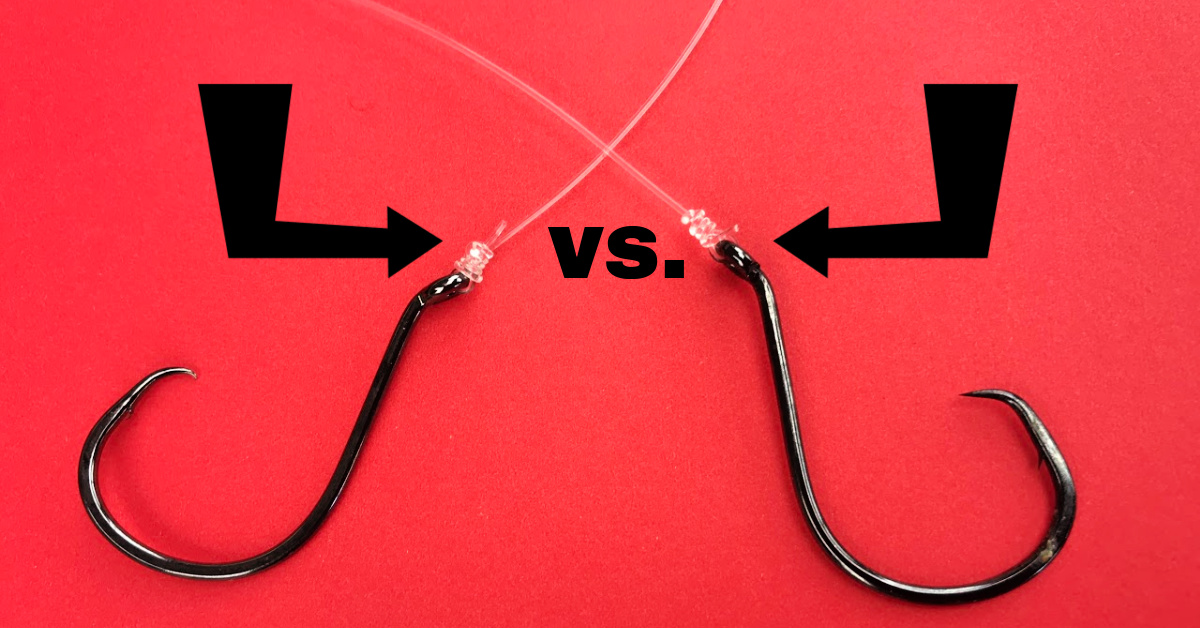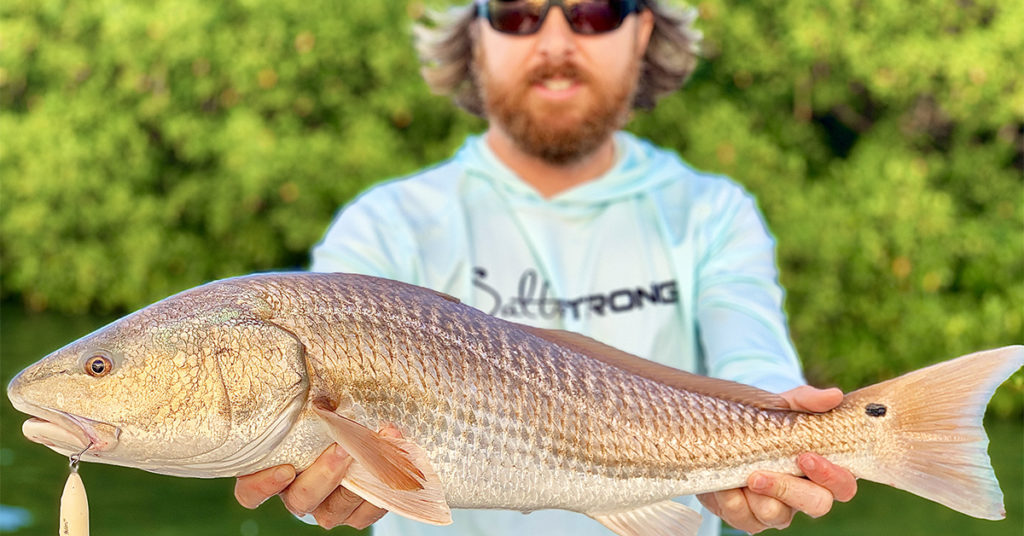Uni Knot Vs. Clinch Knot (The Ultimate Fishing Knot Strength Test)
- By: Luke Simonds
- on
- Found In: Fishing Knots, Fishing Tips, Knot Contest, Weekly Newsletter: 5-30-21

Do you tie a clinch knot when using braid?
If so, then you definitely need to reconsider that decision.
I recently tested the knot strengths between the uni knot and the clinch knot using braid, mono, and fluoro.
These are two very popular knots, but one hands-down outperforms the other in different scenarios.
See the surprising results of this experiment below!
Uni Knot vs. Clinch Knot Strength Test [VIDEO]

There was a clear winner in the mono line contest, a close race for flouro, and a shocking result for the braid.
Both the clinch knot and the uni knot were tied with 5 turns for the mono and flouro knots.
And I used 10 turns for the braided line.
Here are the lines used for the contest:
Here are the full results of the experiment:

As you can see, the clinch knot (also called the fisherman’s knot) won both the mono and flouro contests.
But completely tanked when tied with braid.
So I would highly recommend not using a clinch knot if you’re tying braid.
Check out all of our fishing knot contests here.
Click here if you want to learn how to tie the clinch knot.
And click here if you want to learn how to tie the uni knot.
Conclusion

Sometimes these experiments have very close results and sometimes they are very one-sided.
And sometimes the outcome may completely shock you and make you understand how important the right knot can be!
Do you have other knots you would like to see tested?
Let me know down in the comments!
And if you know someone who uses both knots, please TAG or SHARE this with them!
P.S. Want access to our best fishing spots and tips, plus discounts to our online tackle store? Click here to join us in the Insider Club!
Related articles:
Related categories:
STOP WASTING TIME ON THE WATER!
Do what the “SMART ANGLERS” are doing and join the Insider Club.
Here’s what you’ll receive today when you join:
- Weekly fishing reports and TRENDS revealing exactly where you should fish every trip
- Weekly “spot dissection” videos that walk you through all the best spots in your area
- Exclusive fishing tips from the PROS you can’t find anywhere else
- Everything you need to start catching fish more consistently (regardless if you fish out of a boat, kayak, or land).










The hooks shown with the bent eye need to be snelled so when you set the hook you’re pulling on the shank of the hook not the eye. This improves your hookset.
Mono gets the clinch knot.
Braid gets a palomar knot.
What is the reason for recommending the palomar knot for braid? My tests on braid have almost always shown the winner going to the knot with the most surface area of coverage, and the palomar knot is so small that it doesn’t allow for much surface area to ensure a consistently strong connection.
I’m one that often uses a palomar for braid as well, what knot do you prefer over the palomar, and why?
I prefer this modified uni knot for braid because it scored much better on knot strength tests compared to the palomar: https://saltstrongdev.wpengine.com/articles/braid-uni-knot/
How about using the improved clinch knot vs the uni knot on braid? Thanks…
The extra turn will likely add a slight benefit to the Clinch knot.
How about uni knot vs nail knot
Why tie a clinch or uni to uni to a bent eye style hook?
A knot-less knot or Snel knot would have been the proper knot to tie on this style of a hook, in my opinion.
That was just the first hook that.I saw when I opened my tackle box… the test was solely focused on strength when tied to a hook, so all I cared about was that it had an eye to tie to:)
Really appreciate the knot investigation. I’ve had some issues with knot slip before and was stymied on how to resolve it. Simple graphs, scientifically based, makes choices simple. Thanks for staying “Sponsor Free”. See you on the water!
I’ve been playing this fishing game for 60+ years and, as it happens, I have some rather extensive scientific experience with what you’re trying to test so I’ll offer some observations.
“Way back when” I worked alongside the Stren folks at Dupont. We did these tests a LOT and demonstrated them a LOT at trade shows, etc. The results were quite consistent. We typically looked at Palomar vs Uni vs Clinch and Improved Clinch………..and Palomar was the clear winner, with more varied results from the others.
-Uni Knot worked best with minimum six turns and improved slightly with seven or even eight turns, so I question why you used five?
-Straight Clinch knot worked better than Improved Clinch with very light line (up to 6 Lb test) but was subject to slipping with larger line and hooks. Improved Clinch worked better with larger line and hooks.
-Uni Knot outperformed either Clinch knot about 95% of the time. Of note is the fact that the Trilene Knot (which seems to get little love) generally beat either version of the original Clinch style as well, giving results fairly close to the Uni.
-All of these results were with Stren or Magnathin lines.
-Variations in testing equipment DO matter. Using a real Instron machine was most accurate and repeatable….as would be expected based on its’ expense.
-The person tying the knot DOES matter……..as folks often vary a lot in their attention to detail.
Over the years I’ve seen results for lots of other people doing similar tests and am left to conclude that the line used and who’s doing the tying account for a significant degree of the variability that arises.
Overall my preference is still Palomar first, seven turn Uni second. I’ve never had either pull out, whereas the same can’t be said for the Clinch. The bottom line from my perspective is: Use the knot YOU have the most confidence in.
Thanks for sharing the helpful insights Hal!
I completely agree that the results of these tests can vary based on the person tying the knots. And I believe that the lines used is a big factor as well since some lines handle certain loads better than others.
The reason I used 5 turns for both knots in this test was because that seemed to be what most online videos showed… the core goal was to see which style of knot (clinch vs. uni) did a better job at protecting the line per turn.
Since the Clinch seems to have been the victor, the next test will dig into the different variations of it (Modified Clinch & Trilene).
Thanks for all the work Luke! 🙂
Have you tried the other two types (Improved and Trilene) clinch knots?
Not in detailed experiment yet… but coming up soon.
Yes , I would like to see the palomar knot on Braid
Here’s a link to a Palomar test I did a while back… did pretty good on braid, but there are definitely better options. https://saltstrongdev.wpengine.com/articles/strongest-palomar-knot/
I have used the Palomar knot for just about everything I fish for , and it’s held . I see all of the pro’s and cons for them all and have determined that I don’t see enough evidence to switch up now . I’m relatively new to inshore, but have been fishing for a long time and unless I see something that tells me different, will stick to what works for me on braid ( which is a new thing ) or tying fluorocarbon to braid .
I have learn it doesn’t matter which clinch knot you use. They both hold up for stronger deep water fishing offshore. With in seconds I have lost fish on uni knots. Now I know why I don’t use it anymore. I also know if you don’t slick down the clinch knots. It will weaking the knot due to it meltdown.
The Basic Clinch Knot. Or the Improved Clinch Knot?
This was just the basic… the goal was to see if the basic form of the Clinch knot does a better job at protecting the line compared to the basic Uni design.
Gotcha. I like the way the Basic Clinch Knot’s tag end faces back towards the eye.